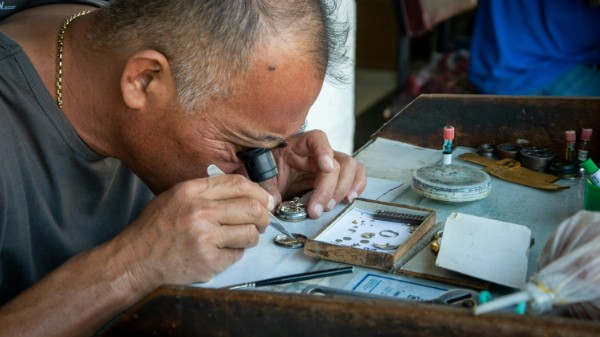A matte finish is a distinctive surface treatment in jewelry manufacturing that provides a soft, non-reflective appearance. Unlike a high polish or satin finish, a matte finish diffuses light rather than reflecting it, resulting in a muted texture that emphasizes the shape and design of the jewelry. This finish is popular for those seeking a modern, understated look. In this article, we will explore what a matte finish is, the techniques used to achieve it, and its significance in the jewelry industry.
What is a Matte Finish?
A matte finish is a surface treatment applied to jewelry that creates a flat, non-reflective appearance. The matte effect is achieved by using abrasives to roughen the surface of the metal, giving it a subtle, velvety texture. This finish is highly effective at reducing glare and enhancing the form of the jewelry piece.
- Purpose: The primary purpose of a matte finish is to provide a sophisticated, subdued look that accentuates the shape of the jewelry without the distraction of shine. It is ideal for those who prefer a minimalist aesthetic or want their jewelry to have an artistic, contemporary feel.
- Standardization: Matte finishes can vary in texture and intensity, ranging from a light, diffused finish to a more pronounced, almost frosted effect. Jewelers can customize the matte finish to match the overall design concept of the piece.
Techniques for Achieving a Matte Finish
Sandblasting:
- Overview: Sandblasting is a common technique used to achieve a matte finish by bombarding the jewelry surface with fine abrasive particles. This process creates an even, matte texture that covers the entire piece.
- Applications: Sandblasting is typically used for jewelry pieces like rings, pendants, and bracelets to create a uniform matte finish. It is particularly effective for larger surfaces where a consistent texture is desired.
Matte Buffing:
- Overview: Matte buffing uses specialized buffing wheels with coarse abrasives to create a matte effect on the jewelry. Unlike traditional polishing, matte buffing deliberately roughens the surface to reduce reflectivity.
- Applications: Matte buffing is often used for flat or gently curved surfaces, such as the band of a ring or the back of a pendant. It is a quick and effective way to achieve a matte appearance.
Chemical Etching:
- Overview: Chemical etching involves applying an acid solution to the metal surface, which lightly corrodes the metal and gives it a matte texture. This technique provides a unique, soft finish that can be controlled by varying the concentration and application time of the acid.
- Applications: Chemical etching is typically used for precious metals like gold and silver, creating an elegant matte effect that can be used for both contemporary and vintage-style jewelry.
Importance of Matte Finish in Jewelry Manufacturing
- Modern Aesthetic: A matte finish offers a modern, artistic look that appeals to those who prefer minimalist jewelry. The lack of shine emphasizes the form and geometry of the piece, making it an ideal choice for jewelry with bold shapes or intricate designs.
- Emphasizing Texture: The matte finish creates a soft, tactile texture that invites touch. It emphasizes the craftsmanship involved in the creation of the jewelry, allowing the subtle details of the metalwork to stand out without the distraction of high reflectivity.
- Versatility: Matte finishes are versatile and can be used in combination with other finishes to create contrast. For example, a matte band with polished edges or a matte pendant with a high polish bezel around a gemstone can create a visually interesting piece that draws attention to specific elements of the design.
Practical Considerations for Matte Finish
- Metal Type: The metal used plays a significant role in the final appearance of a matte finish. Gold, platinum, and silver all respond differently to matte finishing techniques, with each metal producing a unique look. For instance, yellow gold with a matte finish has a warm, buttery appearance, while white metals like platinum and silver have a cool, subdued luster.
- Maintenance: While a matte finish is effective at concealing minor scratches, it can also become smoother over time with wear, particularly in areas that come into frequent contact with clothing or skin. To maintain the matte effect, periodic refinishing by a professional jeweler may be required.
- Combining with Gemstones: Matte finishes work well with gemstone settings, as they create a contrasting backdrop that makes the gemstones appear more vibrant. The matte surface highlights the sparkle of the gemstones, providing a striking visual balance between the metal and the stone.
Matte Finish in Jewelry Manufacturing Process
The process of achieving a matte finish begins with shaping and preparing the jewelry piece. Once the piece is formed, the jeweler uses abrasive techniques such as sandblasting, buffing, or chemical etching to create the desired matte effect. The jeweler may adjust the intensity of the abrasives or chemicals to achieve the specific level of matte finish required.
After applying the matte finish, the piece may be selectively polished to create contrasting elements, or gemstones may be set to enhance the overall design. Careful attention is given to ensure that the matte texture is even and consistent across all surfaces of the jewelry. The final result is a sophisticated piece that combines a contemporary matte texture with the unique characteristics of the metal and any gemstones used.
Conclusion
A matte finish is a refined and versatile surface treatment in jewelry manufacturing that creates a soft, non-reflective appearance. By diffusing light rather than reflecting it, a matte finish emphasizes the form, craftsmanship, and texture of the jewelry, making it an ideal choice for modern and artistic designs. Whether achieved through sandblasting, matte buffing, or chemical etching, the matte finish adds an element of understated elegance to jewelry, enhancing its visual appeal without overwhelming the design. Understanding the techniques and practical considerations involved in achieving a matte finish allows jewelers to craft pieces that are both visually striking and uniquely personal.



